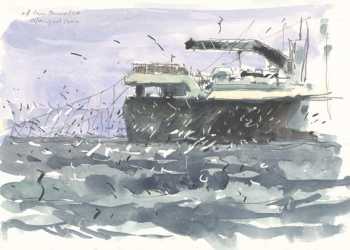Johanna Pierre and colleagues (Dragonfly Data Science) have produced a draft report for the Conservation Services Programme of the New Zealand Department of Conservation on cryptic mortality of seabirds in New Zealand longline and trawl fisheries.

Painting of deployed bird-saving lines by Bruce Pearson
The report’s executive summary follows:
“Understanding the nature and extent of interactions between commercial fisheries and marine protected species is one component of best practice fisheries management. These interactions can lead to mortalities of protected species, which may be detected (e.g., by fisheries observers on vessels), or not readily detectable, and undetected (also known as cryptic mortalities). For seabirds, cryptic mortalities may result, for example, when a bird carcass falls into the water after striking a trawl warp, or when a bird is landed alive on deck, removed from fishing gear and released, but later dies as a result of injuries sustained. The assessment of the risk that New Zealand commercial fisheries represent to seabird populations, conducted by Richard & Abraham (2013), considers cryptic mortality using a set of multipliers applied across the various fishing methods. These scalars are derived from sources including data collected in New Zealand and internationally.
Here, we draw on Richard & Abraham’s (2013) approach, updated in 2014, to identify seabird species and fisheries for which cryptic mortality contributes particularly strongly to the overall assessed risk. We review assumptions and uncertainties inherent in Richard & Abraham’s (2014) methods, as well as relevant new information which may contribute to the development of more robust cryptic mortality scalars applicable to New Zealand fisheries. Finally, we recommend options to improve the estimation of cryptic mortality for the seabird species groups and fisheries where this is particularly important.
From Richard & Abraham’s (2014) assessment, cryptic mortality was especially influential in determining overall assessed risk for both albatross and petrel species, including black petrel (Procellaria parkinsoni) interacting with small-vessel surface and bottom longline fisheries, and Salvin’s (Thalassarche salvini) and New Zealand white-capped (T. cauta steadi) albatross interacting with small inshore trawl vessels, and southern Buller’s albatross (T. bulleri bulleri) interacting with large trawl vessels with meal plants. Key assumptions included that cryptic mortality scalars derived from fisheries outside New Zealand were appropriately applied to the New Zealand context despite differences in seabird assemblages, fishing operations and gear. Further, scalars applied to cryptic mortality of seabirds due to aerial warp strikes and interactions with trawl nets were entirely assumption-based.
Relevant new information that may contribute to refining scalars describing cryptic mortality includes work conducted on cryptic mortality associated with a Falkland Islands demersal trawl fishery, and two new studies reporting the outcomes of seabird strikes on trawl warps. Additional data sources that could prove valuable for the development of improved scalars include the database collected on seabird interactions with trawl fisheries in the Conservation of Antarctic Marine Living Resources Convention Area and from trawl fisheries off the Falkland Islands. Given the seabirds and fisheries for which cryptic mortality is a particularly important determinant of overall risk, and the additional information that may be available, priority areas for improving estimates of cryptic mortalities in New Zealand fisheries include developing method-specific cryptic mortality scalars for bottom longline fisheries, exploring existing information to refine scalars applicable to inshore fisheries, and refining estimates of mortalities – both observed and cryptic - that result from aerial warp strikes. Applying scalars for broad groupings of large (i.e., predominantly albatrosses) and small seabirds appears appropriate given current information. The immediate amendment of data collection protocols used by New Zealand fisheries observers is recommended to document cryptic seabird mortalities. The implementation of new data collection protocols, potentially combined with experimental data collection, are also considered priorities in order to develop an understanding of cryptic mortality, especially in inshore fisheries.”
Reference:
Pierre, J.P., Richard, Y. & Abraham, E.R. 2014. Assessment of Cryptic Seabird Mortality due to Trawl Warps and Longlines. Draft Report prepared for the Department of Conservation: Conservation Services Programme Project INT2013-05. Wellington: Dragonfly Data Science. 46 pp.
John Cooper, ACAP Information Officer, 26 November 2014

 English
English  Français
Français  Español
Español